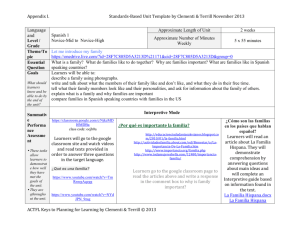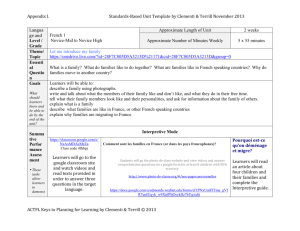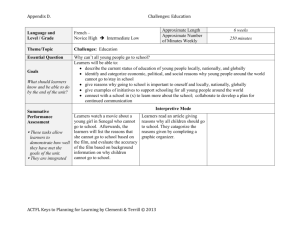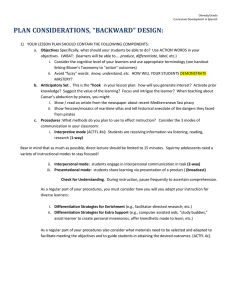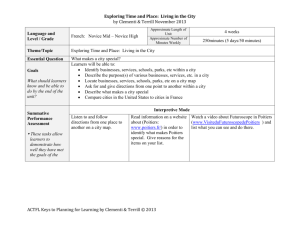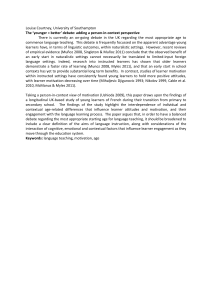Setting Assessing Perf Targets -Handout
advertisement
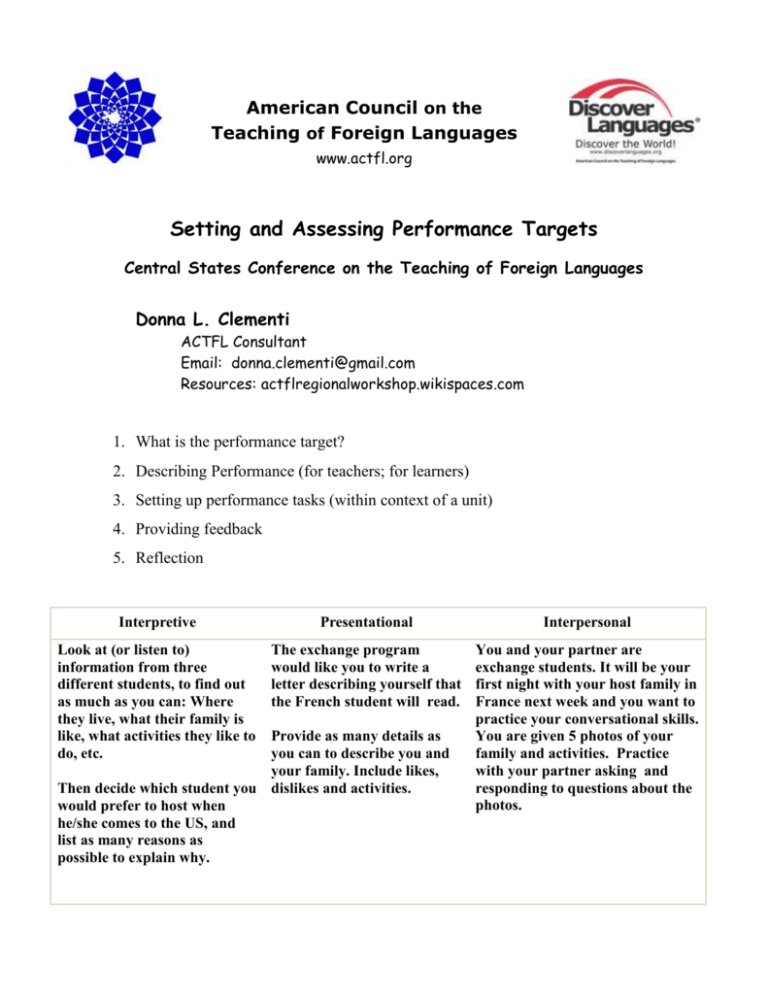
American Council on the Teaching of Foreign Languages www.actfl.org Setting and Assessing Performance Targets Central States Conference on the Teaching of Foreign Languages Donna L. Clementi ACTFL Consultant Email: donna.clementi@gmail.com Resources: actflregionalworkshop.wikispaces.com 1. What is the performance target? 2. Describing Performance (for teachers; for learners) 3. Setting up performance tasks (within context of a unit) 4. Providing feedback 5. Reflection Interpretive Presentational Interpersonal Look at (or listen to) information from three different students, to find out as much as you can: Where they live, what their family is like, what activities they like to do, etc. The exchange program would like you to write a letter describing yourself that the French student will read. You and your partner are exchange students. It will be your first night with your host family in France next week and you want to practice your conversational skills. You are given 5 photos of your family and activities. Practice with your partner asking and responding to questions about the photos. Provide as many details as you can to describe you and your family. Include likes, Then decide which student you dislikes and activities. would prefer to host when he/she comes to the US, and list as many reasons as possible to explain why. CSCTFL – Clementi: Performance Targets – 13 March 2013 - Page 2 Focusing Standards-Based Instruction: (Starting with the End Goals in Mind) 1. 2. 3. 4. Lead with culture (Motivation) Identify the performance assessment (What success looks like) Create meaningful tasks (Planning to “get there”) Determine tools needed for success (Select content) Performance Descriptors for Language Learners (2012) http://www.actfl.org/publications/guidelines-and-manuals/actfl-performance-guidelines-k-12learners The ACTFL Performance Descriptors for Language Learners are designed to describe language performance that is the result of explicit instruction in an instructional setting. These new Performance Descriptors reflect how language learners perform whether learning in classrooms, online, through independent project-based learning, or in blended environments. Describe the language performance of language learners in Standards-based, performance-oriented learning environments Provide descriptive performance outcomes adaptable to fit differences in languages and learners Are organized according to: o Three Ranges of Performance – Novice, Intermediate, Advanced o Three Modes of Communication – Interpersonal, Interpretive, Presentational o Domains of Performance Parameters for the Language Learner’s Performance Functions (global tasks the learner can perform in the language) Contexts (situations within which the learner can function) and Content (topics which the learner can understand and discuss) Text Type (that which the learner is able to understand and produce in order to perform the functions of the level) How and how well the language learner is able to be understood and to understand Language Control (How accurate is the language learner’s language?) Vocabulary (How extensive and applicable is the language learner’s vocabulary?) Communication Strategies (How does the language learner maintain communication and make meaning?) Cultural Awareness (How is the language learner’s cultural knowledge reflected in language use?) CSCTFL – Clementi: Performance Targets – 13 March 2013 - Page 3 INTERPERSONAL SCORING GUIDE No Sometimes Offers an idea or opinion to begin the discussion Yes Comments/examples Adds new information to discussion Responds to other’s comments/questions Asks questions Listens attentively TALK Score (Shrum and Glisan) (+ Consistently, √OK, -never or rarely) Target language Accurate Listens Student #1 Student #2 Student #3 Scored Discussion Move from: Only responds when asked Asks random questions Gives short responses Dominates the discussion Repeats ideas that others already contributed 1 -3 - 5 Kind Move to: Volunteers comments related to the discussion Asks follow-up questions related to what someone else said Gives responses with details, reasons, explanations Invites others to give their opinions, ideas Adds ideas, insights, additional information to make the discussion more interesting STANDARDS-BASED THEMATIC UNIT PLAN Language and Level French – Novice Mid Novice High Theme Contemporary Life : A Balanced Lifestyle Important/Essential Question(s) How balanced is your lifestyle? What do you do to be healthy? Goals What should students know and be able to do by the end of the unit? Students will be able to compare lifestyles of their family members with those of families in (Epernay) in terms of balance. Students will be able to make recommendations for ways to create or maintain balanced lifestyles. Students will explore health and wellness websites to identify elements of a healthy lifestyle. Students will create a presentation for the (community) highlighting ways to promote balance of life. Interpretive Students will read a blog written by a teenager where he discusses his activities. They will demonstrate comprehension by citing evidence to identify main ideas given in English and will complete a graphic organizer based on information found in the text. Performance Tasks Do these tasks allow students to demonstrate how well they have met the goals of the unit? Do the tasks allow students to demonstrate the 4Cs of the 21st Century Skills – Communication, Collaboration, Critical Thinking and Creativity? Cultures Performance assessment Presentational Interpersonal Students will create a presentation for the community highlighting ways to promote a balanced lifestyle. They might participate in a wellness fair or create a virtual wellness fair online. Product: Practice: Perspective: Café Stopping with friends for coffee It’s not the coffee, it’s the conversation ACTFL Unit Template Design – December 2012 – Clementi/Terrill In pairs or small groups, students share what they have learned about their lifestyle and their family’s lifestyle in terms of balance. STANDARDS-BASED THEMATIC UNIT PLAN Cultures Product: Practice: Perspective: School year calendar Regular breaks, holidays Balance Culture Comparisons Work time/leisure time Mealtime with/without family Weekend activities Walking/driving Teenagers working during school year/summer Life expectancies Work to live/live to work Other Disciplines Connections Communities Language “la joie de vivre” “metro, boulot, dodo” “Ne t’en fais pas!” Détente Making polite recommendations Technology Health and wellness: Compare recommendations Teachers can create a safe, free space for student for healthy lifestyles blogs and more: http://kidblog.org Media studies: Impact of media on lifestyles; marketing diet/exercise Look at a community-based issue related to balanced lifestyles and offer solutions Examine personal lifestyles and make adjustments as needed Reading: 1. Read closely to determine what the text says explicitly and to make logical inferences from it; cite specific textual evidence when writing or speaking to support conclusions drawn from the text. Writing: 6. Use technology, including the Internet, to produce and publish writing and to interact and collaborate with others. Connections to Common Core Writing: 7. Conduct short as well as more sustained research projects based on focused questions, demonstrating understanding of the subject under investigation. Speaking and Listening: 1. Prepare for and participate effectively in a range of conversations and collaborations with diverse partners, building on others’ ideas and expressing their own clearly and persuasively. ACTFL Unit Template Design – December 2012 – Clementi/Terrill STANDARDS-BASED THEMATIC UNIT PLAN Language: 4. Determine or clarify the meaning of unknown and multiple-meaning words and phrases by using context clues, analyzing meaningful word parts, and consulting general and specialized reference materials, as appropriate. Tool Box Language Functions Structures / Patterns Compare lifestyle routines plus que, moins que, aussi que Describe your daily schedule (le) lundi… Ask and answer questions about daily routines interrogative pronouns and adjectives Express frequency saying when and how often you do adverbs certain things Express needs saying what you need to do to be Il faut / Il me faut healthy Express opinions about daily activities, schedules Il est important de, Il est bon de Make suggestions about ways to be healthy Tu devrais / Vous devriez Il te/vous faut Vocabulary Development Une bonne hygiène de vie Un régime équilibré La détente Faire de l’exercice Se détendre/se dépêcher Être détendu/être stressé Souvent/rarement De temps en temps Normalement (x) fois par jour/semaine/mois Key Learning Activities Mode of Communication Activity Purpose In-class / Home Interpersonal Pictures/names of famous people: I can (run faster) than (famous person) Practice comparisons In class Interpretive Healthy meal: “Qu’appelle-t-on un repas équilibré”? Reading: main idea/supporting details Home Resources ACTFL Unit Template Design – December 2012 – Clementi/Terrill
